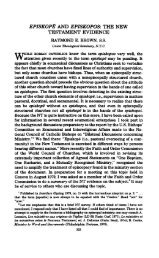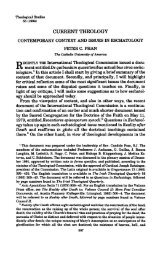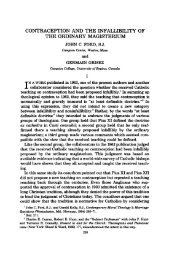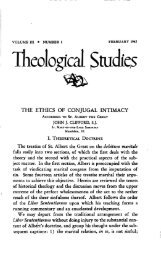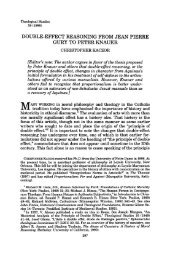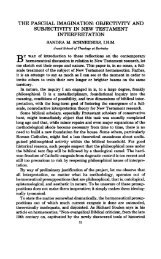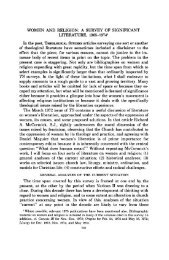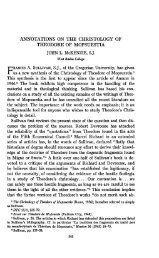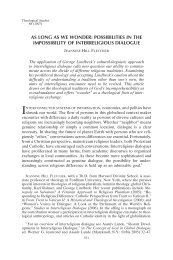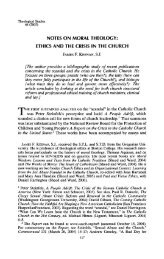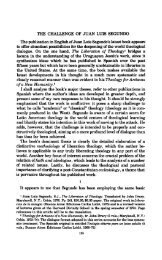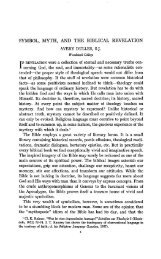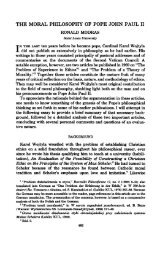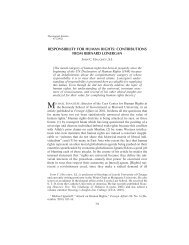Two Concepts of Attrition and Contrition - Theological Studies
Two Concepts of Attrition and Contrition - Theological Studies
Two Concepts of Attrition and Contrition - Theological Studies
You also want an ePaper? Increase the reach of your titles
YUMPU automatically turns print PDFs into web optimized ePapers that Google loves.
6 THEOLOGICAL STUDIES<br />
contrition <strong>and</strong> <strong>of</strong> confession-absolution. The lepers <strong>of</strong> the gospel narrative<br />
were cleansed before they showed themselves to the priests;<br />
Christ Himself resuscitated Lazarus <strong>and</strong> then bade His apostles untie<br />
his b<strong>and</strong>ages. 11<br />
Yet it is also clear from the same history <strong>of</strong> penitential ideas that<br />
theologians were aware <strong>of</strong> the gradual preparation to this contrition,<br />
in which the consideration <strong>of</strong> motives—fear, for example—was believed<br />
to start the penitent on the road to repentance. 12 Without giving it the<br />
name which will later become a theological <strong>and</strong> dogmatic phrase, they<br />
know an inceptive <strong>and</strong> imperfect sorrow for sin which is yet insufficient<br />
for the forgiveness <strong>of</strong> sin in penance, because it does not reach<br />
the stage <strong>of</strong> contrition proper.<br />
Next to this accepted idea that only real contritio cordis is helpful<br />
for the remission <strong>of</strong> sin, we may, with P. de Blic, 13 point to another<br />
reason why no distinction is made between contrition <strong>and</strong> attrition,<br />
namely, the unsettled <strong>and</strong> uncertain theology about the proper efficiency<br />
<strong>of</strong> absolution. Few theologians before St. Thomas attributed<br />
to the priest's sentence more than a declarative or a forensic value. 14<br />
2) The first explicit mention <strong>of</strong> attrition <strong>and</strong> its contrast with contrition<br />
we find in Alanus <strong>of</strong> Lille (+ 1202). 15 His text reads as follows:<br />
"Malum quod est in homine, ut fornicatio vel aliud criminale peccatum,.<br />
. . aut attritione remittitur [that is, minuitur], ut qu<strong>and</strong>o aliquis<br />
dolet se hoc commisisse, cessans ab opere, quamvis non paeniteat<br />
"perfecte; aut contritione dimittitur, qu<strong>and</strong>o plenarie de peccato convertitur.<br />
Sunt enim multi qui dolent se peccasse et corde atteruntur, non<br />
11<br />
Cf. Teetaert, op. cit., pp. 92-93; Schmoll, op. cit., p. 16 (St. Anselm).<br />
12<br />
Cf. Schmoll, op. cit., p. 17 (S. Anselm), p. 24 (St. Bernard), p. 31 (Abelard), p. 49<br />
(Hugh <strong>of</strong> St. Victor), p. 69 (P. Lombard).<br />
13<br />
Op. cit., p. 339.<br />
14<br />
Cf. Teetaert, op. cit., p. 102 (St. Anselm), p. 108 (Abelard), p. 125 (Hugh <strong>of</strong> St.<br />
Victor), p. 140 (P. Lombard); Schmoll, op. cit., p. 17 (St. Anselm), pp. 32 f. (Abelard),<br />
p. 52 (Hugh <strong>of</strong> St. Victor), p. 70 (P. Lombard). Let it, however, be noted that this declarative<br />
value <strong>of</strong> the absolution is not the same as the Protestants would later conceive it;<br />
for the early Scholastics agree to consider confession-absolution as necessary; they only<br />
fail to synthesize this necessity with the justifying role <strong>of</strong> contrition.<br />
15<br />
In the printed sources at any rate. L<strong>and</strong>graf {Grundlage, p. 164) mentions a contemporary<br />
or earlier use <strong>of</strong> the term in the Quaestiones <strong>of</strong> the Cod. Paris. Mazarin lat. 1708<br />
fol. 245v ascribed to Praepositinus <strong>of</strong> Cremona ("Aliud est contritio cordis et aliud attrition,<br />
<strong>and</strong> in Simon <strong>of</strong> Tournai, op. cit., p. 176. Cf. H. Weisweiler, S. J., "Die Busslehre<br />
Simons von Tournai," in Zeitschr. f. kath. Theol., LXV (1932), pp. 190-230, esp. p. 193.



